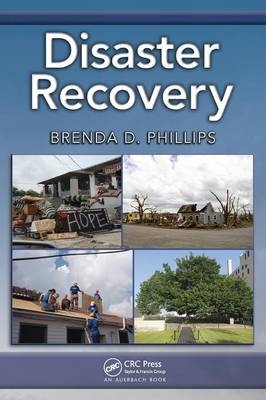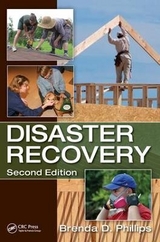
Disaster Recovery
Auerbach (Verlag)
978-1-4200-7420-8 (ISBN)
- Titel erscheint in neuer Auflage
- Artikel merken
Disaster recovery is often unplanned for in the emergency management life cycle. Yet recovery is the key stage where funds, programs, professional expertise, and volunteer efforts are applied to affected cities, states, and regions to get them up and running again. Providing a unique perspective on a highly focused area, Disaster Recovery is the first core text that tackles the myriad recovery issues faced by federal, state, and local emergency managers, public officials, and voluntary organizations in a long-term disaster recovery situation.
The book takes a holistic approach, integrating the various challenges of recovery such as housing, the infrastructure, and workplaces. Disaster Recovery emphasizes three key themes by integrating vulnerable populations into each chapter, stressing the importance of tying mitigation measures into every aspect of recovery, and encouraging rebuilding in environmentally sustainable ways. Coverage includes topics such as recovery planning, housing, debris management, business and private sector recovery, public/governmental recovery and operations, historical and cultural preservation, environmental recovery, social and psychological recovery and services, voluntary non-governmental organizations (NGOs), federal assistance programs, grant-writing, and donations management.
Pedagogical tools to clarify concepts
Each chapter features pedagogy to encourage comprehension and retention, including key terms, learning objectives, highlighted practical applications, review questions, a summary, and references. Numerous classic and recent case studies ensure concepts are fully explained and illustrated. In addition, PowerPoint® slides are also available for adopters. Designed for professional and classroom use, this volume thoroughly covers the disaster recovery process, offering vital insight into the evolving field of emergency management.
Brenda Phillips, Ph.D., is the Associate Dean and Full Professor of Sociology at Ohio University-Chillicothe. She is the author of Mennonite Disaster Service and an editor on Social Vulnerability to Disasters (CRC Press). In 2013, she was inducted into the International Network of Women in Emergency Management’s Hall of Fame. In 2012, she received the Blanchard Award for Excellence in Emergency Management Education. Professor Phillips has conducted research on disaster recovery since 1982, beginning as a student of E.L. Quarantelli at The Ohio State University’s Disaster Research Center. Her published research can be found in a variety of journals including the International Journal of Mass Emergencies and Disasters, Disaster Prevention, Disasters, Humanity and Society, the Journal of Emergency Management, Natural Hazards Review, and Environmental Hazards. She has been funded multiple times by the National Science Foundation to study disasters and vulnerable populations. Dr. Phillips has been invited to teach, consult or lecture in New Zealand, Australia, Germany, India, Costa Rica, Mexico, Canada, and the People’s Republic of China. She is a graduate of Bluffton University (Ohio) and The Ohio State University.
I. Understanding Disaster Recovery
Introduction
Types of Disasters
Definitions: Key Terms and Concepts
Recovery as a Process
Presidential Declarations
Frameworks and Approaches to Disaster Recovery
Theoretical Frameworks
Challenges of Recovery
Damage Assessment
A Sustainable, Holistic Approach to Recovery
Disaster Recovery Planning
Getting Started with Planning
Recovery Planning
Short-Term Recovery Planning
Long-Term Recovery Planning
II. Dimensions of Disaster Recovery
Debris Management
Hazard-Specific Debris Problems
Problems Specific to Debris
Debris Estimation
Debris-Management Planning
Debris-Reduction Methods
Planning for the Action Stages
Environmental Recovery
Approaches to Environmental Recovery
Strategies and Tools for Environmental Recovery
Environmental Partners
Historic and Cultural Resources
The Importance of Historic Places
Challenges and Opportunities after Disaster
Resources for Historic and Cultural Preservation
Building Mitigation into Historic and Cultural Resource Recovery
Housing
Challenges and Problems
Approaches to Housing Recovery
Types and Definitions of Disaster Housing
Business Recovery
Conditions that Influence Business Recovery
Challenges during the Recovery Period
Strategies for Business Recovery
Funding Business Recovery
Disaster-Resilient Businesses
Infrastructure and Lifelines
The Social Impacts of Infrastructural and Utility Damage
The Impacts of Disaster on Infrastructure and Utilities
Damage Assessment
Infrastructure and Utility Recovery
Mitigating Future Risks
Social Psychological Recovery
Psychological Impacts of Disasters
Factors Influencing Social Psychological Recovery
Building Resilience to Disaster Trauma
Social Psychological Recovery
Public-Sector Recovery
Roles of Government
Recovery Challenges and Opportunities
Key Governmental Resources
III. Recovery Resources
Donations
Understanding Why People Donate in Disaster Situations
Challenges Associated with Donations
Donations during the Recovery Period
Donations Management Planning
Donations Accountability
Community Resources
Defining Community
The Value of Community Involvement for Disaster Recovery
Community Engagement
Participatory Strategies
Voluntary Organizations
Why People Volunteer
Benefits and Challenges of Volunteers and Voluntary Organizations
Types of Volunteers and Voluntary Organizations
Contributions of Voluntary Organizations During Disaster Recovery
The Federal Government and Voluntary Agencies
Volunteer Management
Financing Recovery
Grant Writing
Traditional Federal Recovery Resources
Foundation Grants
Glossary
Index
| Erscheint lt. Verlag | 12.5.2009 |
|---|---|
| Zusatzinfo | 40 Boxes; 12 Tables, black and white; 53 Illustrations, black and white |
| Verlagsort | London |
| Sprache | englisch |
| Maße | 178 x 254 mm |
| Gewicht | 1134 g |
| Themenwelt | Sozialwissenschaften ► Soziologie |
| ISBN-10 | 1-4200-7420-2 / 1420074202 |
| ISBN-13 | 978-1-4200-7420-8 / 9781420074208 |
| Zustand | Neuware |
| Haben Sie eine Frage zum Produkt? |
aus dem Bereich



